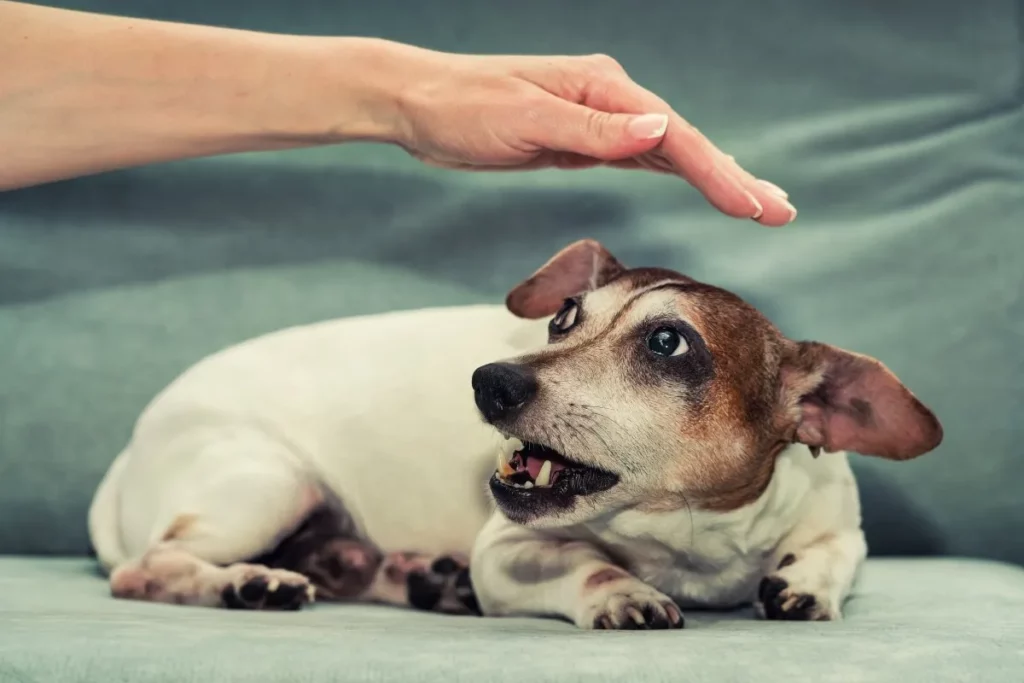Do you want to discover the subtle signs your dog is scared of you and deepen your bond by understanding your canine companion’s emotions? Learn how to create a trusting environment for your furry friend.

Dogs communicate through body language, and recognizing signs of fear is vital.
Sometimes, if your dog is scared of you, you need to watch out for a tucked tail, flattened and ears.
These subtle cues indicate anxiety and discomfort in your dog.
Furthermore, you need to understand your dog’s emotions is crucial for a harmonious relationship.
As you keep on reading, you will get to explore the various signs your dog is scared of you and how you can foster a sense of security.
Signs Your Dog is Scared of You

Here are the eight clear signs that indicate your dog is scared of You
1. You Notice Excessive Yawning From Your Dog
Excessive yawning or licking lips are silent indicators that your dog is scared of you.
When your dog exhibits these behaviors, it’s crucial to assess the environment and your interactions for potential stressors.
2. Your Dog Constantly Tucks Its Tail Between it’s Legs
A tucked tail is a silent yet powerful indicator of a scared dog. When a dog consistently tucks its tail between its legs, it’s revealing a fear response.
Also, this subtle body language is a clear signal that your dog is experiencing discomfort or anxiety.
Furthermore, paying attention to the position of their tail provides crucial insights into their emotional state, allowing you to address and alleviate their fears effectively.
3. Your Dog Starts Avoiding You
Dogs are inherently social animals, and sudden avoidance behavior can be a red flag for fear.
If your once playful pup starts avoiding eye contact, or physical touch, or retreats to a secluded spot, it may indicate fear or discomfort.
Furthermore, recognizing these avoidance cues is essential for understanding your dog’s emotional well-being and taking the necessary steps to create a safe and reassuring environment.
4. Your Dog Begins to Exhibit Excessive Panting When Around You
While panting is a normal behavior for dogs, excessive panting, especially in non-stressful situations, can be indicative of anxiety.
Also, monitoring your dog’s breathing patterns allows you to decode their stress levels.
Excessive panting may accompany other signs of fear, and addressing the underlying causes can help alleviate their stress and create a more comfortable environment.
5. Noticing Your Dog Constantly Whimpering or Whining
Dogs communicate their discomfort through various vocalizations, and whimpering or whining can be their way of expressing fear.
Furthermore, understanding the context and identifying patterns in their vocal cues is crucial for effective communication.
Also, whimpering may indicate a need for reassurance and comfort, prompting a caring response to alleviate their fears.
6. Your Dog Constantly Lacks Appetite
A sudden loss of interest in food is a significant sign of anxiety in dogs.
If your once voracious eater becomes hesitant during mealtime, it’s crucial to investigate the underlying cause, considering fear as a potential factor.
Also, fear-related stress can impact a dog’s appetite, and addressing their emotional well-being is essential to restore healthy eating habits.
7. Your Dog Exhibits Uncontrollable Shiver When Around You
Similar to humans, dogs may experience physical tremors when anxious or scared.
If you notice your dog trembling or shivering without an apparent cause, it’s essential to assess their environment and interactions for potential stressors.
Also, understanding the source of their fear-induced shivers allows you to create a supportive and comforting atmosphere to help them regain confidence.
8. Your Notice Your Dog’s Ears Pinned to the Back
Ears play a crucial role in a dog’s communication, and pinned-back ears can be a clear sign of fear or submission.
Observing your dog’s ear position in various situations provides valuable insights into their emotional state.
Also, pinned-back ears signal discomfort, and responding with reassurance and positive interactions can help alleviate their fears.
9. You Sometimes Receive Aggressive Responses From Your Dog
Surprisingly, fear in dogs can sometimes manifest as aggression.
If your usually friendly dog displays aggression, it may be a defensive reaction triggered by fear.
Understanding the root cause is crucial for addressing and resolving such behavior.
Responding with patience, positive reinforcement, and gradual exposure to fear-inducing stimuli can help your dog overcome their anxieties and build confidence.
In conclusion, being attuned to your dog’s behavior is the key to fostering a healthy and trusting relationship.
By recognizing these eight signs of fear, you can take proactive steps to address and alleviate your dog’s anxiety.
Remember, a happy and confident dog is a reflection of a caring and attentive owner who prioritizes their emotional well-being.
Related Searches:

Leave a Reply